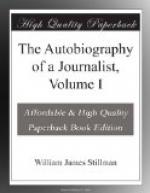The success of “The Crayon” was immediate, though, from a large journalistic point of view, it was, no doubt, somewhat crude and puerile. It had a considerable public, sympathetic with its sentimental vein, readers of Ruskin and lovers of pure nature,—a circle the larger, perhaps, for the incomplete state of art education in our community. That two young men, without any experience in journalism, and with little in literature, should have secured the success for their enterprise which “The Crayon” indisputably did enjoy was a surprise to the public, and, looking at it now, with my eyes cooled by the distance of more than forty years, I am myself surprised. That “The Crayon” had a real vitality, in spite of its relative juvenility, was shown by the warm commendation it received from Lowell, Bryant, and other American literati, and from Ruskin, who wrote us occasional notes in reply to questions put by the readers, and warmly applauded its tone. Mantz was our French correspondent, and William Rossetti our English, and a few of the artists sent us communications which had the value of the personal artistic tone. But I learned the meaning of the fable of “The Lark and her Young,” for the general assistance in the matter of contributions, promised me by the friends who had originally urged me to the undertaking, was very slow in coming, and, for the first numbers, I wrote nearly the whole of the original matter, and for some time more than half of it. I wrote not only the editorial articles and the criticisms, but essays, correspondence, poetry, book notices (really reading every book I noticed), and a page or two of “Sketchings,” in which were notes from nature, extracts from letters, and replies to queries of the readers.
I remained in the city all the burning summer, taking a ten days’ run in the Adirondacks in September. I kept office all day, received all who came to talk art or business, and did most of my writing at night,—not a regime to keep up one’s working powers. Durand did some excellent translations from the French, and the late Justin Winsor sent us many translations, both of verse and prose, from the German, as well as original poetry. Aldrich was a generous contributor. Whittier, Bayard Taylor, and others of the lyric race sent occasional contributions, and amongst the women, who were, as a rule, our most enthusiastic supporters,




